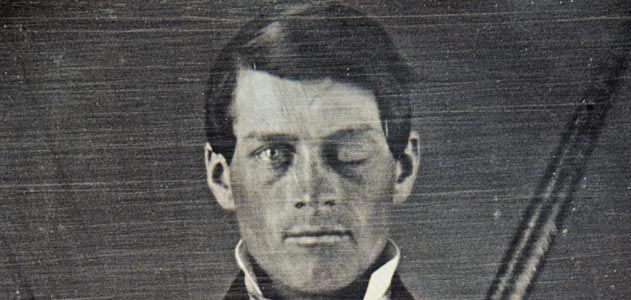It was not an extraordinary day in Cavendish, Vermont. To most people, this day was perfectly normal. September 13, 1848 was just another Wednesday. Phineas Gage, a foreman working for Rutland & Burlington Railroad, would have agreed that this day was no different from any other. Or, at least that’s how it started.1
On this day in September 1848, Gage was only 25 years old. Gage, by all means, was not extraordinary. He was very average. He stood at 5 feet 6 inches, and he was physically strong, as was needed for his job. He was kind, well-mannered, intelligent, and had a good temper. On this day, Gage was putting explosive powder into an iron. It was part of his job, and something he had done before. Gage, a cautious man, usually paid attention to what he was doing. For some reason, he turned his head for a second. He looked away. That was all it took. In one second, his life changed forever.2
The powder Gage was putting into the iron activated, causing an explosion. Surprised, he didn’t have a time to react. The force blew him from where he was standing, and he landed a couple of feet away from his original position. The iron rod went through his left cheek and then out of his skull. Days later it was found by Gage’s men, about 80 feet away from where Gage landed, smeared with blood and brain.3

Miraculously, Gage didn’t pass out from the impact or the bleeding. He got up, went to the town, went into a hotel, and waited there for a doctor. All with little help. When the local doctor arrived, Gage spoke to him and said, “Doctor, here is business enough for you.” Dr. Williams couldn’t believe him — if his story was true and an iron went through his head, how was Gage still standing and talking? How was he fully conscious? It wasn’t until an Irishman standing nearby added to their conversation, stating the rod was still on the floor over by the railroad, “all blood and bits,” that Dr. William believed him.4
Dr. Williams, realizing he wasn’t exactly qualified to treat Gage’s injury called over Dr. John Harlow. In today’s terms, calling Dr. Harlow a neurosurgeon wouldn’t be correct. At this time, neuroscience wasn’t even known, much less an actual field of study. Still, Dr. Harlow treated Gage and managed to stop the hemorrhage Gage had. Even though Phineas Gage experienced severe trauma, he didn’t seem very bothered, nor did he show any signs of stress. Gage even told the doctor that he didn’t want his friends or family to come visit him. After all, his accident wasn’t very serious, and he would return to work in a couple of days time. Through this process, Gage was conscious, and the traces left by the iron and rust were a testament to his accident.5
It took a while for Gage to recover. Not surprisingly. Dr. Harlow kept a clear record of his whole treatment. He kept an almost day-by-day journal filled with his observations, as well as the treatment Gage was receiving. He had an infection, but as Dr. Harlow treated it, it went away fairly quickly. At times during his recovery, Gage would sometimes seem delirious, but that would clear up almost immediately. It was remarkable.6 Really, no one would have guessed what was truly wrong with him until they analyzed him fully. On top of his head, there was an inverted tunnel showing where the rod had come out of. On his left cheek, there was a hole. Small pieces of Gage’s brain appeared scattered throughout his scalp, stuck to his hair. Dr. Harlow described in his report later on, that as he pressed against Gage’s skull, “The pulsations of the brain were distinctly seen and felt.”7 A month later, Gage was able to stand and walk around. Neurologically, he appeared in tact.

The news of his accident quickly spread. Soon enough, Gage was the main topic for articles in his town. This, however, was not what lead to his fame, in fact, Gage wasn’t exactly flourishing after this accident. It was the opposite.
Physically, he wasn’t much different than before. He was still physically capable, although his left eye would stay shut forever, and the left side of his face was partially paralyzed.8 Dr. Harlow would even go so far as to say he had fully recovered. Gage stated he felt fine, but he had an odd feeling. But, it was a feeling not even he could describe. He had no pain, but something was different in his head.9

Even though he was physically capable of doing most things, he couldn’t hold down a job. His old employer refused to hire him again. Something had changed, and it wasn’t in Gage’s physical performance. After the accident everyone collectively agreed, “Gage was no longer Gage.”10 Dr. Harlow detailed these changes. Reportedly, Gage’s personality and behavior drastically changed. The capable and efficient man people hired and knew was gone. He was replaced by a different type of man. Gage now used profanity, something he hadn’t done before. He showed little emotion or care for his coworkers and previous friends. He was irrational, with a short temper.11

Years after the accident, Gage continued to find himself unemployed. His ill-advised decisions caused by his new personality didn’t land him very far. Instead, Gage sought other ways to make money.12 He exhibited himself as a circus act, carrying the famous iron rod. Of course, every job he held was short lived, and he wasn’t a circus act his whole life. He also traveled traveled. He went from through New England, all the way to Chile. His jobs were mostly manual types of work, like driving a stagecoach. Throughout all his travels, he carried the rod with him, like it was a part of him, his only companion.13
In 1860, at the young age of 36, Gage began to experience seizures. He returned home to California, where he reunited with his mother and sister, his only family. Dr. Harlow would later report that after every epileptic convulsion, Gage had no memory of them. Eventually, on May 21st, 1860, after a series of continuous seizures, Phineas Gage died. It was exactly, “twelve years, six months and eight days after the date of his injury.”14

Phineas Gage’s story, as well as the later exhumation of his bones, led to the discovery and subsequent explorations of the brain. His story is one that’s commonly looked at, and it is referred to as “Neuroscience’s most famous case.”15 It led to advancements in what we now know about brain injuries, and how to treat them. Still, sometimes Phineas Gage himself is forgotten. He should be remembered not just as a case, or as an interesting phenomenon, but as a person. He was a good-looking, kind, confident, assertive, young man.16 He had a family, friends, and lived a good life. He was an ordinary man, who experienced an extraordinary injury. And, we should never forget him for that.
- John Martyn Harlow, “Recovery from the passage of an iron bar through the head,” Publications of the Massachusetts Medical Society 2, no. 3 (1868): 4. ↵
- John Martyn Harlow, “Recovery from the passage of an iron bar through the head,” Publications of the Massachusetts Medical Society 2, no. 3 (1868): 4. ↵
- TL Guidotti, “Phineas Gage and His Frontal Lobe- The “American Crowbar Case”,” Archives of Environmental & Occupational Health 67, no. 4 (2012): 249. ↵
- Malcolm Macmillan, Odd Kind of Fame: Stories of Phineas Gage (Cambridge: MIT Press, 2000), 43-44. ↵
- John Martyn Harlow, “Recovery from the passage of an iron bar through the head,” Publications of the Massachusetts Medical Society 2, no. 3 (1868): 7. ↵
- Andrew Grieve, “Phineas P Gage—‘The man with the Iron bad’,” Trauma 12, no 3 (2010): 172. ↵
- John Martyn Harlow, “Recovery from the passage of an iron bar through the head,” Publications of the Massachusetts Medical Society 2, no. 3 (1868): 5. ↵
- TL Guidotti, “Phineas Gage and His Frontal Lobe- The “American Crowbar Case”,” Archives of Environmental & Occupational Health 67, no. 4 (2012): 249-250. ↵
- John Martyn Harlow, “Recovery from the passage of an iron bar through the head,” Publications of the Massachusetts Medical Society 2, no. 3 (1868): 12. ↵
- TL Guidotti, “Phineas Gage and His Frontal Lobe- The “American Crowbar Case”,” Archives of Environmental & Occupational Health 67, no. 4 (2012): 249-250. ↵
- John Martyn Harlow, “Recovery from the passage of an iron bar through the head,” Publications of the Massachusetts Medical Society 2, no. 3 (1868): 11-12. ↵
- Encylopedia of Social Psychology, 2007, s.v. “Social Cognitive Neuroscience,” by Matthew D. Lieberman. ↵
- TL Guidotti, “Phineas Gage and His Frontal Lobe- The “American Crowbar Case”,” Archives of Environmental & Occupational Health 67, no. 4 (2012): 249-250. ↵
- John Martyn Harlow, “Recovery from the passage of an iron bar through the head,” Publications of the Massachusetts Medical Society 2, no. 3 (1868): 14. ↵
- Andrew Grieve, “Phineas P Gage—‘The man with the Iron bad’,” Trauma 12, no 3 (2010): 173. ↵
- TL Guidotti, “Phineas Gage and His Frontal Lobe- The “American Crowbar Case”,” Archives of Environmental & Occupational Health 67, no. 4 (2012): 250. ↵




50 comments
Maria Cossio
Gage’s case has always been an extremely interesting case to learn about and especially in the field of Neuroscience. It’s intriguing how major areas of the brain were affected but physically not much was damaged, rather behavior-wise it was seen as a major difference. You did a great job with this article!
Dylan Vargas
I really like this article, it tells the story of Phineas Gage, who got a metal pipe through his head and still survived. I think I like the article’s topic about the effect that the rod left on him and what it did to his brain. Gage died young so the fact that the pipe going through his brain had something to do with his death. Also, I liked how it explained that because of Gage, doctors and scientists were able to understand the effects and how to treat some brain problems. The effects of what happened to him like his personality changing and others make this article very well done.
Gabriella Parra
Wow! You hooked me right away with your writing style! I recently saw a video that lightly touched on Phineas Gage, but they failed to mention his personality change. I’d love to hear some theories on what happened to his brain from experts in psychology. I’d especially like to know why he wasn’t physically reacting to the pain of such a catastrophic injury. Great read!
Kenneth Cruz
The case of Phineas Gage is truly one that has shaped the fields of biology and psychology. His case played a role in learning about the anatomy of the brain and how each part of it functions. It also helped in learning how personality is derived from a certain part of the brain. The Gage that everyone knew disappeared after the accident and no one really understood why.
Azariel Del Carmen
It was bit of a shock how he survived. I found the description of his life and injury a accurate tale to what others refer to in history about him. It’s sad how we changed due to it, which looks like was a part of his brain being missing causing his head to lose control and while now people debate his injury, it is still something worthy to cover still and learn more about
Sophia Rodriguez
I have heard of Phineas Gage but I never knew anything specific about him, so reading this I am just amazed at what had happened. I am just utterly shocked at how he was still moving around and was not in pain, while he still had the rod in his head. I do feel bad because Gage tried to live a normal life once he could go work again, but the accident that happened to him affected him so bad he was not the same person again. I also did not know that his case is referred to as “Neuroscience’s most famous case.”
Bailey Godwin
This article was very interesting and hooked my attention right away. It is amazing that the rod penetrated his head in such a way that he was ultimately okay. It is also very interesting to see that the injury ended up doing damage to his brain and his personality but it was over a longer period of time. It is horrible he died from the seizures and the people around him no longer recognized him.
Kayla Mendez
As another psychology major, I recognize that this case has a famous status in the field. I liked that you highlighted his humane features, and focused on who he was rather what discoveries he brought. It’s sad to know that a man’s identity was forcefully changed forever, and he had no way to change it. It makes me wonder, did he remember how he used to be? If he did, did he miss it? If he didn’t, his story becomes even more disheartening.
Berenice Alvarado
This article was amazing. The story of Phineas Gage was new to me. I didn’t know someone survived such a crazy traumatic event. Imagine a whole in your brain. Even though science in the 19th century I was amazed of how the doctors that treated him saved his life all while he was conscious. I was shook when I read the part that he went to his hotel room and waited for the doctor like if nothing was wrong. I really liked this article and I learned something new.
Mia Hernandez
This was a very good and fascinating article to read. I had never heard of Phineas Gage or the traumatic incident that he endured. It is crazy to think that an individual could survive getting impaled in the head by a rod. But it is awful to find out that the repercussions of the event led to a complete wipe of his previous personality.